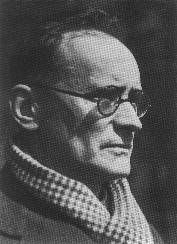Introduction
(born Vienna, 3 December 1883; died Mittersill, 15 September 1945).
He studied at Vienna University under Adler (1902-6), taking the doctorate
for work on Heinrich Isaac; in composition he was one of Schönberg's
first pupils (1904-8), along with Berg. Like Berg, he developed rapidly
under Schönberg's guidance, achieving a fusion of Brahms, Reger and
tonal Schönberg in his orchestral Passacaglia, already highly characteristic
in its modest dynamic level and its brevity. But he was closer than Berg
in following Schönberg into atonality, even choosing verses by the
same poet, Stefan George, to take the step in songs of 1908-9. His other
step was into a conducting career, which he began with modest provincial
engagements before World War I. After the war he settled close to Schönberg
in Mödling and took charge of the Vienna Workers' Symphony Concerts
(1922-34). Meanwhile he had continued his atonal style, mostly in songs:
the relatively few instrumental pieces of 1909-14 had grown ever shorter,
ostensibly because of the lack of any means of formal extension in a language
without key or theme. However, the songs of 1910-25 show a reintroduction
of traditional formal patterns even before the arrival of serialism (especially
canonic patterns, no doubt stimulated, as was the instrumentation of many
of these songs, by Pierrot lunaire), to the extent that the eventual
adoption of the 12-note method in the Three Traditional Rhymes (1925) seems
almost incidental, making little change to a musical style that was already
systematized by strict counterpoint.
However, Webern soon recognized that the 12-note principle sanctioned
a severity and virtuosity of polyphony that he could compare with that
of the Renaissance masters he had studied. Unlike Schönberg, he never
again sought to compose in any other way. Rather, the highly controlled,
pure style of his Symphony appears to have represented an ideal which later
works could only repeat, showing different facets. His use of the series
as a source of similar motifs, especially in instrumental works, merely
emphasizes the almost geometrical perfection of this music, for which he
found literary stimulus in Goethe and, more nearly, in the poetry of his
friend and neighbour Hildegard Jone, whose words he set exclusively during
his last dozen years. With Schönberg gone, Berg dead and himself deprived
of his posts, Webern saw Jone as one of his few allies during World War
II. He was shot in error by a soldier after the end of hostilities, leaving
a total acknowledged output of about three hours' duration.
Extracted with permission from
The Grove Concise Dictionary of Music
edited by Stanley Sadie
© Macmillan Press Ltd., London. |
Detailed Information about
-
Picture Gallery
-
List of Works
-
Bibliography
can be found on the internet on:
Classical Music Pages:  |
This project was created by Matt Boynick.
© 1 February 1996
Last Revision - 25 August 1999
|

